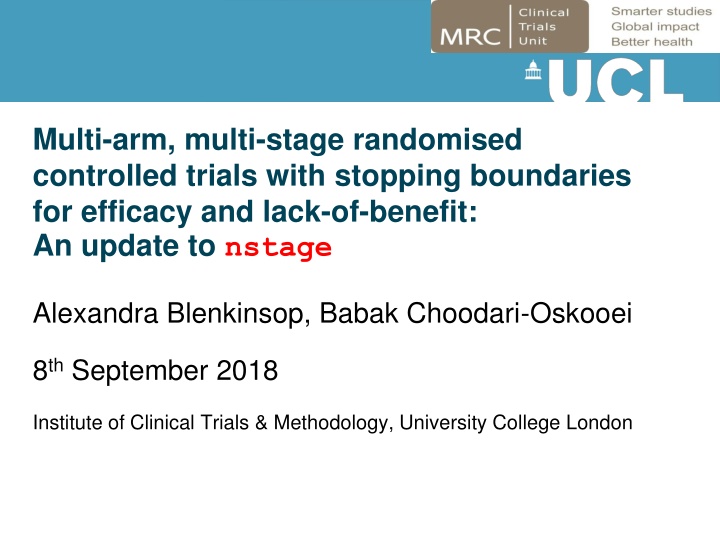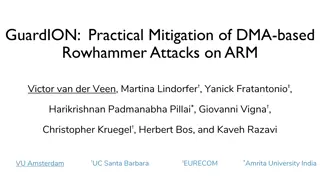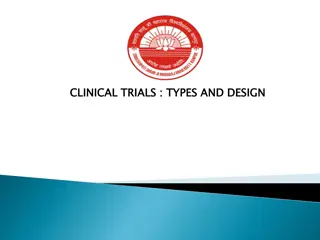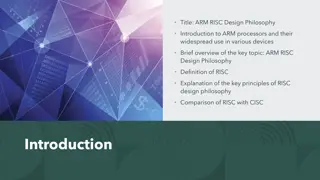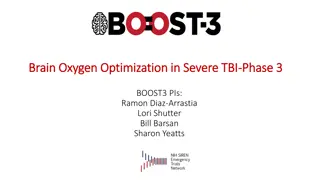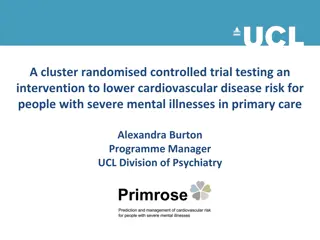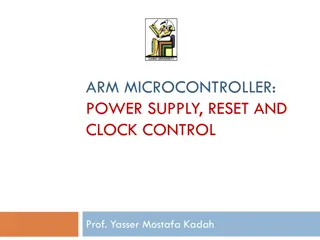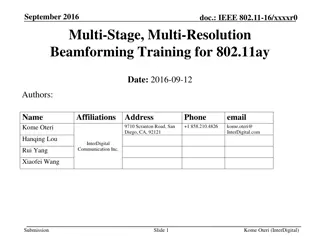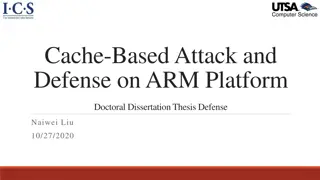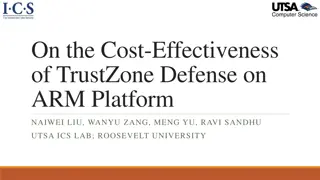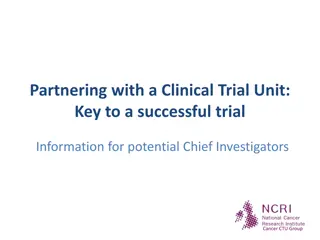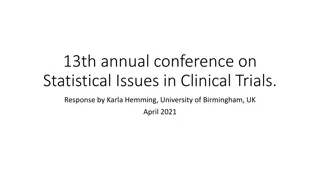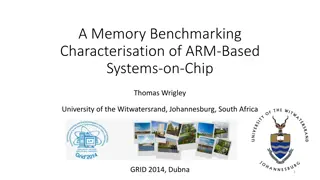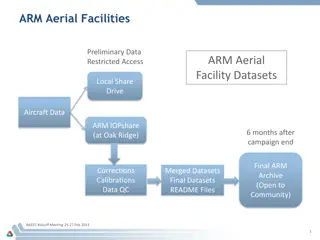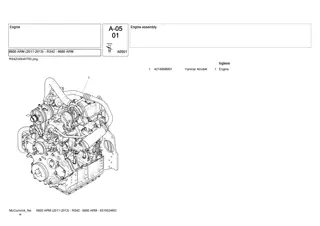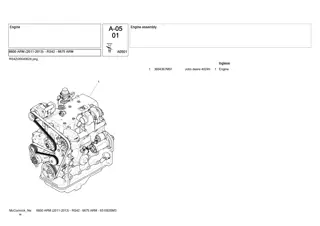Multi-Arm, Multi-Stage Randomised Trials Update
Explore the latest insights on multi-arm, multi-stage randomised controlled trials, including design extensions, case studies like the STAMPEDE trial, benefits, operating characteristics, and software tools like nstage Stata program. Understand the significance of stopping boundaries for efficacy and lack of benefit, with a focus on MAMS methods and their impact on trial outcomes.
Download Presentation

Please find below an Image/Link to download the presentation.
The content on the website is provided AS IS for your information and personal use only. It may not be sold, licensed, or shared on other websites without obtaining consent from the author.If you encounter any issues during the download, it is possible that the publisher has removed the file from their server.
You are allowed to download the files provided on this website for personal or commercial use, subject to the condition that they are used lawfully. All files are the property of their respective owners.
The content on the website is provided AS IS for your information and personal use only. It may not be sold, licensed, or shared on other websites without obtaining consent from the author.
E N D
Presentation Transcript
Multi-arm, multi-stage randomised controlled trials with stopping boundaries for efficacy and lack-of-benefit: An update to nstage Alexandra Blenkinsop, Babak Choodari-Oskooei 8thSeptember 2018 Institute of Clinical Trials & Methodology, University College London
Outline Introduction to MAMS and nstage Design extensions and new options Example: STAMPEDE trial Discussion
A brief history of trials First RCT (1946) Adaptive designs Group sequential design MAMS
MAMS design Multi-Arm Multi-Stage (MAMS) Methods by Royston et al (2003,2011) For time-to-event outcomes Extended to binary Phase III Multiple research arms, 1 common control arm Uses intermediate outcome (I) observable before definitive outcome (D) for Lack-Of-Benefit (LOB) assessment ? ? E4 E5 Control E1 E2 E3 Stage 1 Stage 2 Stage 3
MAMS design Benefits Increased probability of success See data as it accrues Time & resource efficient Considerations Multiple testing impacts operating characteristics Correlation between test statistics E1 E2 Control Stage 2 Stage 1 Stage 3
Operating characteristics of MAMS Type I error: Pairwise error rate (PWER) The probability of rejecting any null hypothesis on the definitive/primary (D) outcome for a particular experimental arm Familywise error rate (FWER): multi-arm setting The probability of incorrectly rejecting any null hypothesis for the D-outcome. Type II error rate: Probability of correctly concluding efficacy All-pairs, Per-pair, Any-pair Which measure of power in a multi-arm trial?
Software: nstage Stata program developed for designing MAMS trials (Barthel & Royston, 2009; Bratton et al 2015) Calculates: Sample size requirements Operating characteristics Expected timings of stages User-friendly menu
Software: nstage Example output
Example: STAMPEDE 6-arms 4- stages 3 interim analyses to assess LOB Intermediate outcome: FFS Final efficacy stage with ? = 0.025 to declare efficacy Definitive outcome: OS Stop recruitment Stop recruitment
MAMS design 0.6 0.5 0.4 Alpha 0.3 0.2 0.1 Reject ?? 0 1 2 3 4 Stage
MAMS design 0.6 0.6 0.5 0.5 0.4 0.4 Alpha Alpha 0.3 0.3 0.2 0.2 0.1 0.1 Reject ?? 0 0 1 1 2 2 3 3 4 4 Stage
Efficacy stopping boundaries Haybittle-Peto O-Brien- Fleming type Custom (e.g. function of information time) Lack-of-benefit rejection region Efficacy rejection region
Approaches to stopping early for efficacy If an efficacious arm is identified early: Terminate trial or continue with remaining research arms May depend on Research question: Whether treatment arms are distinct/related Ethics: Patients on an inferior control arm Practicality: Can efficacious treatment be added to other arms? (i.e. combination therapy) Binding vs. non-binding lack-of-benefit boundaries Non-binding favoured by regulatory agencies: Considered more flexible Calculation of error rates is more conservative
Specifying efficacy stopping boundaries New option esb(string[,stop]) Haybittle-Peto O Brien-Fleming Custom rules Error rates are estimated via simulation Accounting for correlation between treatment effects Output shows stopping boundary p-values for each stage and operating characteristics stop option: How to proceed if an arm crosses efficacy bound Some trials may continue with remaining research arms (or add effective regimen to all arms and continue i.e. combination therapy trial) Or may be unethical to continue trial once an effective arm has been identified
Controlling the FWER Trial regulators sometimes require the overall type I error (FWER) to be controlled Particularly for designs which allow early termination for efficacy Option fwercontrol(#)allows user to specify the maximum FWER permitted nstage searches for a design which satisfies this constraint using linear interpolation
Example: STAMPEDE . nstage, nstage(4) alpha(0.5 0.25 0.1 0.025) omega(0.95 0.95 0.95 0.90) > hr0(1 1) hr1(0.75 0.75) accrue(500 500 500 500) arms(6 6 6 6) aratio( > 0.5) t(2 4) Operating characteristics Alpha(1S) Power HR H0 HR H1 Crit.HR Length* Time* Stage 1 0.5000 0.950 1.000 0.750 1.000 2.436 2.436 Stage 2 0.2500 0.951 1.000 0.750 0.924 1.120 3.556 Stage 3 0.1000 0.951 1.000 0.750 0.886 1.091 4.647 Stage 4 0.0250 0.900 1.000 0.750 0.844 2.176 6.823 Pairwise** 0.0118 0.834 6.823 Familywise(SE)** 0.0521 (0.0004) Maximum Pairwise Alpha 0.0250 Maximum Familywise Alpha 0.1030 * Length (duration of each stage) is expressed in one year periods and assumes survival times are exponentially distributed ** Calculated under global null hypothesis for I and D outcomes Note: Only 3 research arms reached the final stage so the actual FWER was 6.7%
Example: STAMPEDE - - - - Final stage significance level is adjusted Operating characteristics meet the constraint Length of trial increases Number of control arm events increases
Return list Additional estimates produced by return list 3 estimates of power (relevant for multi-arm trials) P-values for efficacy stopping boundaries Estimated primary outcome events at interim analyses When ? ? and timing of analysis is based on the intermediate outcome events observed May be useful in deciding whether or not to implement efficacy boundaries
Validating the new nstage Independently coded the algorithm Checked the simulation results against analytical solutions where possible Re-ran the design do files of previous MAMS trials, compared the outputs/results, and checked for discrepancies The algorithm (and nstage) has been applied to design new MAMS trials in renal cancer with time-to-event outcome.
Discussion nstage can design a MAMS trial assessing lack-of-benefit on I-outcome and efficacy on D-outcome for time-to-event outcome measures To our knowledge the only software that does such a complex design We use it for all of our MAMS designs, i.e. STAMPEDE, RAMPART, RUSSINI2, TB MAMS Trial, Choosing an efficacy boundary Depends on design parameters We have developed practical guidelines (Blenkinsop, Parmar, Choodari-Oskooei, 2018) Control of the FWER Not always required, but our approach is fast, easy to apply and ensures high power early in trial
Discussion Binding vs. non-binding a useful addition Often a regulatory requirement to assume non-binding boundaries nstage allows users to compare both approaches Stopping vs. continuing with trial Depends on trial, ethical considerations, practicality nstage allows flexibility Speed Favourable compared to alternative freely available software The article to be submitted to Stata journal
References Blenkinsop, A., Parmar, M. K. B., Choodari-Oskooei, B. (2018), Assessing the impact of efficacy stopping rules on the error rates under the MAMS framework, Clinical Trials (under review) Blenkinsop, A., Choodari-Oskooei, B. (2018), Multi-arm, multi-stage randomized controlled trials with stopping boundaries for efficacy and lack-of-benefit: An update to nstage, Stata Journal (to be submitted) Royston, P., Barthel, F. M.-S., Parmar, M. K. B., Choodari-Oskooei, B., & Isham, V. (2011). Designs for clinical trials with time-to-event outcomes based on stopping guidelines for lack of benefit. Trials, 12(1), 81. Barthel, F. M.-S., & Royston, P. (2009). A menu-driven facility for sample-size calculation in novel multiarm, multistage randomized controlled trials with a time-to-event outcome. Stata Journal, 9(4), 505 523. https://doi.org/The Stata Journal Bratton, D. J., & Choodari-Oskooei, B. (2015). A menu-driven facility for sample-size calculation in multiarm, multistage randomized controlled trials with time-to-event outcomes: Update. Stata Journal, 15(2), 350 368. Sydes, M. R., Parmar, M. K. B., Mason, M. D., Clarke, N. W., Amos, C., Anderson, J., James, N. D. (2012). Flexible trial design in practice - stopping arms for lack-of-benefit and adding research arms mid-trial in STAMPEDE: a multi-arm multi-stage randomized controlled trial. Trials, 13(1), 1.
